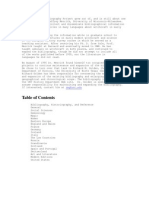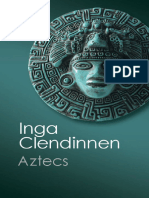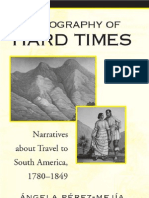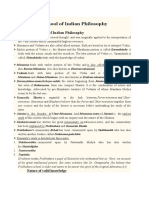Weigle 1983
Weigle 1983
Uploaded by
Joao PedroCopyright:
Available Formats
Weigle 1983
Weigle 1983
Uploaded by
Joao PedroOriginal Title
Copyright
Available Formats
Share this document
Did you find this document useful?
Is this content inappropriate?
Copyright:
Available Formats
Weigle 1983
Weigle 1983
Uploaded by
Joao PedroCopyright:
Available Formats
BOOK REVIEWS AND NOTES 347
Jackson, M., 1977, The Kuranko: Dimen- Toelken, B., 1969, The "Pretty Language"
sions of Social Reality in a West African So- of Yellowman: Genre, Mode, and Texture in
ciety. London: Hurst. Navajo Coyote Narratives. Genre 2:211-35.
Seitel, P., 1980, See So That We May See: Toelken, B., and T. Scott, 1981, Poetic
Performances and Interpretations of Tradi- Retranslation and the "Pretty Languages" of
tional Tales from Tanzania. Bloomington: Yellowman. Pp. 65-116 in Traditional Ameri-
Indiana University Press. can Indian Literatures: Texts and Interpreta-
Tedlock, D., 1978, Finding the Center: tions (ed. by K. Kroeber). Lincoln and London:
Narrative Poetry of the Zuni Indians. Lincoln University of Nebraska Press.
and London: University of Nebraska Press. Marta Weigle
The Image of Guadalupe: Myth or Miracle? Neither the present team nor its predeces-
Jody Brant Smith. Garden City, New York: sors have been as large or as highly specialized
Doubleday & Company, 1983, xiv + 173 pp.; as those scrutinizing the Shroud of Turin.
25 illustrations. $14.95, cloth. Callahan, an entomologist with a biophysics
background, and Smith, an associate professor
On 7 May 1979, and again in April 1981, of philosophy and religion at Pensacola Junior
Philip Serna Callahan and Jody Brant Smith College in Florida and, unlike Callahan, not a
were allowed into the vault of the new basilica Catholic, have published their scientific results
in Mexico City to examine and photograph (in in The Virgin of Guadalupe: An Infrared Study
regular light, in infrared, and with computer (Washington, D.C.: CARA, 1981). The present
enhancement) "Our Lady of Guadalupe, a book is an abbreviated, popular account, and
life-sized image of the Virgin Mary that ap- Smith presents neither the historical and
peared miraculously on the cactus-cloth tilma, scientific evidence nor the project's procedures
or cape, of Juan Diego, an Aztec peasant, in in a systematic, comprehensive way. A fellow
1531" (p. 3). Their Image of Guadalupe Re- of the Institute of Psychic Research, Smith also
search Project thereby joined in basilica annals intersperses his narrative with jarring incidents
a number of others-including official church of personal visions and synchronicity, for
inquiries in 1556 and 1666; examinations example: "The scientific findings regarding the
by such artists as Miguel Cabrera (early 1750s), Shroud of Turin were very much on my mind
Francisco Campa Rivera (1954, 1963), and as I flew back from Mexico City .. . [and] I
Francisco de Guadalupe Mojica (since 1950); considered it a good omen when I picked up
and investigations by such scientists as ophthal- the candy on my dinner tray and found printed
mologists Javier Torroella-Bueno (1950s) and on the wrapper 'Made in Turin, Italy.' " (p. 43).
Enrique Graue (1975). Almost all investigators Anthropologists will find The Image of
have reached conclusions similar to Callahan Guadalupe easygoing but unsatisfying fare.
and Smith's: "Our discovery of the absence of However, the appendices-translations of perti-
undersketching in the Guadalupe and our nent sections from "The Nican Mopohua" (ca.
inability to account for the remarkable state of 1551-61), "The Primitive Relation" (ca. 1573),
preservation of the unsized cactus cloth as well and "The Codex Saville" (fifteenth and six-
as the unfading brightness of the paints or dyes teenth centuries)-and the bibliographical notes
used in the original parts of the painting put Dr. are useful.
Callahan and myself firmly in the ranks of Marta Weigle
those who believe the Image was created
supernaturally" (p. 105).
Curanderismo: Mexican American Folk Healing. and full-time work is as a healer, who sees more
Robert Trotter II and Juan Antonio Chavira. than five patients a day, and who uses all or
Athens: University of Georgia Press, 1981, xi + some significant part of the theoretical system
204 pp.; photographs, glossary, bibliography, described here" (p. 1). Trotter and Chavira level
index. $16.00, cloth; $8.00, paper. harsh criticism at the extant literature. Previous
studies have centered on Mexican American
A curandero, according to Trotter and 'folk' illnesses, such as mal de ojo ("evil eye,"
Chavira, is "a person whose main profession or "bad eye") and susto ("fright"). The present
This content downloaded from 165.123.034.086 on August 08, 2016 04:41:51 AM
All use subject to University of Chicago Press Terms and Conditions (http://www.journals.uchicago.edu/t-and-c).
You might also like
- Malintzin's Choices: An Indian Woman in the Conquest of MexicoFrom EverandMalintzin's Choices: An Indian Woman in the Conquest of MexicoRating: 4 out of 5 stars4/5 (7)
- The Indians’ New World: Catawbas and Their Neighbors from European Contact through the Era of RemovalFrom EverandThe Indians’ New World: Catawbas and Their Neighbors from European Contact through the Era of RemovalRating: 4.5 out of 5 stars4.5/5 (3)
- María Herrera-Sobek - The Mexican Corrido - A Feminist Analysis-Indiana University Press (1990)Document164 pagesMaría Herrera-Sobek - The Mexican Corrido - A Feminist Analysis-Indiana University Press (1990)juanosuarez9009100% (1)
- Whitewashed Adobe: The Rise of Los Angeles and the Remaking of Its Mexican PastFrom EverandWhitewashed Adobe: The Rise of Los Angeles and the Remaking of Its Mexican PastRating: 4.5 out of 5 stars4.5/5 (3)
- Sabine G. MacCormack - CurriculumDocument10 pagesSabine G. MacCormack - CurriculumWALTER DIAZ MONTENEGRONo ratings yet
- Frida Kahlo: Her Life and Art Revisited PDFDocument16 pagesFrida Kahlo: Her Life and Art Revisited PDFperdidalmaNo ratings yet
- Bell and Molina-Gavilan (Ed) - Cosmos Latinos - SF From Spain and Latin America PDFDocument372 pagesBell and Molina-Gavilan (Ed) - Cosmos Latinos - SF From Spain and Latin America PDFnamNo ratings yet
- Colonialism and the Emergence of Science FictionFrom EverandColonialism and the Emergence of Science FictionRating: 4 out of 5 stars4/5 (5)
- Decomposer Poster 1Document3 pagesDecomposer Poster 1api-535379067No ratings yet
- Witchcraft BibDocument309 pagesWitchcraft BibDunjeon100% (2)
- Bynum - The Body of Christ in The Later Middle AgesDocument21 pagesBynum - The Body of Christ in The Later Middle AgesEthan Robey100% (1)
- Dorothea Lange, Migrant Mother, and The Culture of The Great DepressionDocument21 pagesDorothea Lange, Migrant Mother, and The Culture of The Great DepressionJMNo ratings yet
- Exploring The Decolonial Imaginary - Four Transnational LivesDocument279 pagesExploring The Decolonial Imaginary - Four Transnational LivesEka Putra NggaluNo ratings yet
- Mary Page Annotated BibliographyDocument3 pagesMary Page Annotated BibliographyBain WellingtonNo ratings yet
- Can The Subaltern Be SeenDocument29 pagesCan The Subaltern Be SeenMariana BarretoNo ratings yet
- TextoDocument400 pagesTextoHectorNo ratings yet
- Grandin Can-the-Subaltern-Be-Seen PDFDocument29 pagesGrandin Can-the-Subaltern-Be-Seen PDFccastrobcNo ratings yet
- Periodo ColonialDocument4 pagesPeriodo ColonialHerramientas de ComunicaciónNo ratings yet
- Searching for Madre Matiana: Prophecy and Popular Culture in Modern MexicoFrom EverandSearching for Madre Matiana: Prophecy and Popular Culture in Modern MexicoNo ratings yet
- García Barrios Ana Verónica Vázquez López The Weaving of Power Women's Clothing and Protocol in Seventh-Century Kingdom of Kaanu'lDocument49 pagesGarcía Barrios Ana Verónica Vázquez López The Weaving of Power Women's Clothing and Protocol in Seventh-Century Kingdom of Kaanu'lakaren.cabrera989No ratings yet
- Gender in Pre-Hispanic America: Cecelia F. Klein, EditorDocument15 pagesGender in Pre-Hispanic America: Cecelia F. Klein, EditorKarla Ramirez RNo ratings yet
- Nagualism 1Document71 pagesNagualism 1manfredm6435No ratings yet
- Views Selfhood: Perspectives: Of/apanese Japanese and /x/estem 159Document1 pageViews Selfhood: Perspectives: Of/apanese Japanese and /x/estem 159Aikido EurogetNo ratings yet
- Subject and ContentDocument12 pagesSubject and ContentAce CloudNo ratings yet
- American Anlhropologist: of His Work Appeared in Two PrintingsDocument2 pagesAmerican Anlhropologist: of His Work Appeared in Two Printingsrokaku2No ratings yet
- Board of Regents of The University of Oklahoma University of OklahomaDocument2 pagesBoard of Regents of The University of Oklahoma University of OklahomaenviNo ratings yet
- Tantra Sex Secrecy Politics and Power in PDFDocument3 pagesTantra Sex Secrecy Politics and Power in PDFSuresh KrishnaNo ratings yet
- Transmodernity and InterculturalityDocument26 pagesTransmodernity and InterculturalityMorganatillmannNo ratings yet
- The History of Latin America 2020 21Document16 pagesThe History of Latin America 2020 21Oumou KaneNo ratings yet
- Bricker y Vogt (1998), Alfonso Villa RojasDocument5 pagesBricker y Vogt (1998), Alfonso Villa RojasMikjail CarrilloNo ratings yet
- In the Shadow of Quetzalcoatl: Zelia Nuttall and the Search for Mexico’s Ancient CivilizationsFrom EverandIn the Shadow of Quetzalcoatl: Zelia Nuttall and the Search for Mexico’s Ancient CivilizationsNo ratings yet
- Creole Subjects in the Colonial Americas: Empires, Texts, IdentitiesFrom EverandCreole Subjects in the Colonial Americas: Empires, Texts, IdentitiesNo ratings yet
- Envisioning Power: Ideologies of Dominance and CrisisFrom EverandEnvisioning Power: Ideologies of Dominance and CrisisRating: 4.5 out of 5 stars4.5/5 (4)
- Castenada Bibleography PDFDocument3 pagesCastenada Bibleography PDFBrady PyerNo ratings yet
- Casta Painting Art Race and Identity in ColoniaDocument8 pagesCasta Painting Art Race and Identity in ColoniaalbagonezNo ratings yet
- Conflict in Historical Interpretation of The Aztec StateDocument10 pagesConflict in Historical Interpretation of The Aztec StateAlberto FonsecaNo ratings yet
- Inga Clendinnen - Aztecs - An Interpretation-Cambridge University Press (1993)Document501 pagesInga Clendinnen - Aztecs - An Interpretation-Cambridge University Press (1993)Gustavo SoaresNo ratings yet
- National Imaginaries, American Identities: The Cultural Work of American IconographyFrom EverandNational Imaginaries, American Identities: The Cultural Work of American IconographyNo ratings yet
- The Supernatural and The Occult in Selected Poems and Letters of Emily Dickinson (Wright, Stephen Caldwell) (Z-Library)Document77 pagesThe Supernatural and The Occult in Selected Poems and Letters of Emily Dickinson (Wright, Stephen Caldwell) (Z-Library)NaiellyNo ratings yet
- Beyond the Happening: Performance art and the politics of communicationFrom EverandBeyond the Happening: Performance art and the politics of communicationNo ratings yet
- The Value of Ancient Mexican Manuscripts in The Study Oe The General Development of WritingDocument30 pagesThe Value of Ancient Mexican Manuscripts in The Study Oe The General Development of Writinggoosejoker03131987No ratings yet
- A Bibliography of The Published and Unpublished Works of John Leon SorensonDocument16 pagesA Bibliography of The Published and Unpublished Works of John Leon SorensonO993No ratings yet
- Book of Chilam Balam The of Chumayel. by Ralph L Roys 1933. EtextDocument142 pagesBook of Chilam Balam The of Chumayel. by Ralph L Roys 1933. EtextTariq720No ratings yet
- Rhodes Eddy Jesus As Diogenes PDFDocument21 pagesRhodes Eddy Jesus As Diogenes PDFEduardo Montemayor RockeNo ratings yet
- Notes For A History of Peruvian Social Anthropology, 1940 801Document18 pagesNotes For A History of Peruvian Social Anthropology, 1940 801Lizzy Gutiérrez HuayhuaNo ratings yet
- James J. Murphy - The 26th Annual Newberry Library Renalssance Conference - Rhetoric in The Renaissance - A Basic Bibliography (1979, The Newberry Library)Document15 pagesJames J. Murphy - The 26th Annual Newberry Library Renalssance Conference - Rhetoric in The Renaissance - A Basic Bibliography (1979, The Newberry Library)pakitisNo ratings yet
- The University of Chicago Press American Historical AssociationDocument3 pagesThe University of Chicago Press American Historical AssociationPao La LibertàNo ratings yet
- Mathematics of the Incas: Code of the QuipuFrom EverandMathematics of the Incas: Code of the QuipuRating: 3.5 out of 5 stars3.5/5 (7)
- Instant Download Empires of The Dead: Inca Mummies and The Peruvian Ancestors of American Anthropology Christopher Heaney PDF All ChapterDocument64 pagesInstant Download Empires of The Dead: Inca Mummies and The Peruvian Ancestors of American Anthropology Christopher Heaney PDF All Chapternateyshenga100% (5)
- Agrippa's Dilemma: Hermetic 'Rebirth' and The Ambivalences of de Vanitate and de Occulta PhilosophiaDocument38 pagesAgrippa's Dilemma: Hermetic 'Rebirth' and The Ambivalences of de Vanitate and de Occulta PhilosophiaMichael KeeferNo ratings yet
- Missionary Scientists - Jesuit Science in Spanish South America, 1570-1810Document305 pagesMissionary Scientists - Jesuit Science in Spanish South America, 1570-1810paulscribder0% (1)
- The Apparition of Our Lady of GuadalupeDocument14 pagesThe Apparition of Our Lady of Guadalupegeorgejorgen1No ratings yet
- (Latin American and Iberian Thought and Culture)Angela Perez Mejia, Dick Cluster-A Geography of Hard Times Narratives About Travel to South America, 1780-1849-State University of New York Press(2004)Document180 pages(Latin American and Iberian Thought and Culture)Angela Perez Mejia, Dick Cluster-A Geography of Hard Times Narratives About Travel to South America, 1780-1849-State University of New York Press(2004)Lidija ChNo ratings yet
- Staging Christ's Passion in Eighteenth-Century Nahua MexicoFrom EverandStaging Christ's Passion in Eighteenth-Century Nahua MexicoNo ratings yet
- HSK 3 Vocabulary List: Simplified Pinyin Traditional English & ClassifiersDocument14 pagesHSK 3 Vocabulary List: Simplified Pinyin Traditional English & Classifierskol balishNo ratings yet
- 1 Grade-Character Traits: Unit PlanDocument38 pages1 Grade-Character Traits: Unit Planapi-279517519No ratings yet
- Lesson Plan in PSTMDocument9 pagesLesson Plan in PSTMMichael Peralta MahinayNo ratings yet
- Oracle Apps - R12 Payment Document Setup - Oracle Apps TechnicalDocument2 pagesOracle Apps - R12 Payment Document Setup - Oracle Apps Technicalali iqbalNo ratings yet
- Amy Sudol ResumeDocument2 pagesAmy Sudol Resumeapi-283215834No ratings yet
- The Viking Diaspora (Judith Jesch) (Z-Library)Document245 pagesThe Viking Diaspora (Judith Jesch) (Z-Library)Benign Hummingbird Hovering100% (1)
- Final Report - Diego Alexander SotoDocument3 pagesFinal Report - Diego Alexander SotoCarolina de TingoNo ratings yet
- The Ideal Man of GodDocument7 pagesThe Ideal Man of GodJocelyn V RoganNo ratings yet
- ADS Record Final PDFDocument51 pagesADS Record Final PDFArunNo ratings yet
- UAS LinguisticsDocument9 pagesUAS LinguisticsGhina Nur Faridah RahmatNo ratings yet
- C++ Assignment 2Document11 pagesC++ Assignment 2samuel mitikuNo ratings yet
- Class Activity ObjectivesDocument4 pagesClass Activity ObjectivesGoran GothaiNo ratings yet
- Walk Through The Bible #12 - Infancy Narrative, Virgin & Virgin BirthDocument45 pagesWalk Through The Bible #12 - Infancy Narrative, Virgin & Virgin BirthounbblNo ratings yet
- Cause & Effect Conjuncti Ns Exercises: - Go To TheDocument5 pagesCause & Effect Conjuncti Ns Exercises: - Go To TheJean CabingatanNo ratings yet
- MIMAMSA PHILOSOPHY ThursdayDocument4 pagesMIMAMSA PHILOSOPHY ThursdayGaluh SadewaNo ratings yet
- Martini2009 PDFDocument266 pagesMartini2009 PDFIvanovici Daniela100% (1)
- St. Helen Church: 4106 Mountain St. Beamsville, ON L3J 0K9Document4 pagesSt. Helen Church: 4106 Mountain St. Beamsville, ON L3J 0K9sthelenscatholicNo ratings yet
- Arthur MillerDocument2 pagesArthur MillergabryminottiiiNo ratings yet
- Ditar 2.6Document3 pagesDitar 2.6egla berberiNo ratings yet
- Bible VersesDocument2 pagesBible Versesmaria sarojiniNo ratings yet
- Lessonplan 3Document1 pageLessonplan 3api-242368132No ratings yet
- Blending in English and Vietnamese: Group 6 (Friday - Period 123)Document27 pagesBlending in English and Vietnamese: Group 6 (Friday - Period 123)Nguyễn TrangNo ratings yet
- Lesson 22 - ElaDocument11 pagesLesson 22 - Elaapi-357400202No ratings yet
- Should - Shouldn't - Grupo 2Document14 pagesShould - Shouldn't - Grupo 2jade campos avelinoNo ratings yet
- Chaves para OraçãoDocument25 pagesChaves para OraçãoDomínio dominadoNo ratings yet
- Audio-Lingual MethodDocument28 pagesAudio-Lingual MethodLe Hong KhuongNo ratings yet
- Python Summary of Functions and LoopsDocument6 pagesPython Summary of Functions and LoopsheforgiveoursinsNo ratings yet
- Unit-04 Java MCQ - 16944662 - 2023 - 03 - 24 - 19 - 51Document8 pagesUnit-04 Java MCQ - 16944662 - 2023 - 03 - 24 - 19 - 51Ujjwal DubeyNo ratings yet
- Teaching Practice Ii ProgramDocument4 pagesTeaching Practice Ii ProgramSilvia MolinaNo ratings yet

























































































